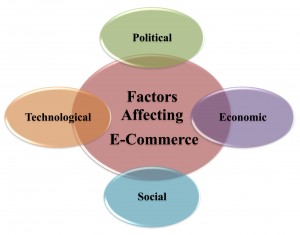Factors affecting E-Commerce /Key Drivers of E-commerce/ Forces fuelling E-commerce
There are many external environmental factors that can affect e- business. It is common for managers to assess each of these factors closely. The aim is always to take better decisions for the firm’s progress. Some common factors are political, economic, social and technological (known as PEST analysis).
1.Political factors
It includes the role of government legislation, initiatives and funding to support the use and development of e-commerce and information technology. Several aspects of government policy can affect e-commerce business. All firms must follow the law. Managers must find how upcoming legislations can affect their activities. The government’s role in developing countries is an important one as it facilitates the essential requirements for the development of E-Commerce such as providing robust secure on-line payment options, ensuring a solid ICT infrastructure, providing educational programs and building up awareness using different means such as media and education institutions.
2.Economic factors
It includes the general wealth and commercial health of the nation and the elements that contribute to it. Economic efficiency results in the reduction of communications costs, low-cost technological infrastructure, speedier and more economic electronic transactions with suppliers, lower global information sharing and advertising costs, and cheaper customer service alternatives. Economic integration is either external or internal. External integration refers to the electronic networking of corporations, suppliers, customers/clients, and independent contractors into one community communicating in a virtual environment (with the Internet as medium). Internal integration, on the other hand, is the networking of the various departments within a corporation, and of business operations and processes. This allows critical business information to be stored in a digital form that can be retrieved instantly and transmitted electronically. Internal integration is best exemplified by corporate intranets. Among the companies with efficient corporate intranets are Procter and Gamble, IBM, Nestle and Intel.
3.Social factors
Incorporating the level and advancement in IT education and training which will enable both potential buyers and the workforce to understand and use the technology. Rising standards of living and a burgeoning,upwardly mobile middle class with high disposable incomes,Busy lifestyles,urban traffic congestion and lack of time for offline shopping have given boost to e-commerce. Evolution of websites such as Flipkart, Snapdeal, ebay etc. has become a market place where seller register with them and pays commission on every sale.
4.Technological factors
The development of ICT is a key factor in the growth of e-commerce. It has made communication more efficient, faster, easier, and more economical as the need to set up separate networks for telephone services, television broadcast, cable television, and Internet access is eliminated. Due to technological advances economic transactions have become much easier and faster and this has given boost to the development of e-commerce.


